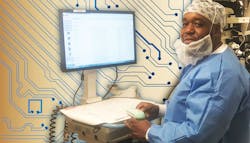While Perioperative Services at Children’s Hospital of Philadelphia may use a lot of high-cost, high-tech devices and equipment to care for its patients, the Central Processing Department is responsible for taking care of those devices and equipment, including reprocessing them and keeping track of them for access and availability.
Ultimately, CPD is working on a more efficient and reliable process to link each flexible endoscope to the patient on which it is used. (See sidebar at www.hpnonline.com/sterile-processing/article/21074825/awardwinning-cpd-posits-reflects-bright-outlook.) CPD recognizes that in the event a problem is identified with a particular scope, the facility must be able to notify the affected patients and treat them accordingly.
Tracking will help as well as controlling access, according to Robert Silverstein, Senior Director, Central Processing and High-Level Disinfection/Sterilization.
Such a process was difficult to achieve as part of the award-winning CPD’s process redesign, Silverstein noted. But CPD and the clinical teams collaborated to streamline how the OR could maintain compliance. Here’s what they did.
- Enhanced Scope Securement — The scope cabinets are locked and CPD manages the access. Prior to this, various members of the clinical teams had access to the scopes making it difficult to manage the inventory and to know where the scopes were used. “Initially there were concerns, more related to emergency cases and access,” Silverstein said. “CPD staffs the scope room 24/7, and we have not had any major issues since this was implemented. This particular location carries scopes that are used within the OR, as well as by residents and fellows for bedside procedures, so tracking and accountability is even more at the forefront.”
- Daily Reporting — Each day, any issues with the return or disbursement of the scopes are reported to the clinical chairs of the departments, and real-time education and feedback is given to the nurse or clinician who used the scope.
- Orientation — The scope disbursement process is embedded into the clinical team’s orientation with the residents and fellows. “The clinical teams who utilize scopes are responsible for providing our policy and procedures for scope disbursement during orientation,” Silverstein said. “We also have annual competencies related to this process that individuals must sign off on. We are also working on a plan to provide more education and training to ensure all key stakeholders are aware of the regulatory components to scope management.”
- Technology Optimization — Microsystems’ SPM system capabilities help streamline the process for CPD and provide more accurate reporting for follow-up.
CPD also hosts periodic instrument fairs to bring front-line and management teams together with nurses and surgeons to review the various specialties sets to identify opportunities for “right-sizing,” according to Pete Schemm, Senior Director, Supply Chain Processes and Technology. “While the goal is to remove items not commonly used, it is also intended to add the instruments the nurses frequently need to retrieve during a case,” Schemm indicated. “This has proven to be a very successful way to reduce waste, condense our inventory, and it allows us to collaborate in a way that we rarely have the opportunity to do so.”
The instrument fairs were originally intended to be held every two months or so and revolve based on surgical specialty, according to Schemm. Perioperative Services and Surgical leadership promoted them as the clinical lead and CPD leader coordinated them. The instrument fairs are designed to focus on existing sets and procedures rather than new instrumentation or conversions, he added.
Teched out, up
To track performance and workflow, CPD uses Microsystems’ SPM platform. “This allows us to identify instrument/set needs, variations by employees, supply versus demand issues, etc. We have utilized this information to show us gaps in performance that needed remediation,” Silverstein said.
CPD recently implemented an interface between SPM and Epic’s OpTime OR management system. “This automates our ‘needs list,’ which is a tool we use to prioritize our work for the following days cases,” Silverstein said. “Prior to this interface, CPD staff spent several hours every night building the cases in SPM manually, which included not only our instrument information, but all of the clinical details as well, including surgeons, room number, patient info, etc. The next phase is building conflict checks in Epic [that] will alert nursing when they have booked more cases than we can support with our existing inventory. This will allow them to prioritize cases taking into account the time needed to turn over sets.”
The SPM-Epic interface has enabled the following improvements:
- Visibility of advanced schedule in that the needs list is generated into the future and add-on cases are immediately visible
- Automated Interference check enablement in Epic for scheduling
- Removal for need to maintain sets in two systems separately as Epic and SPM both have equipment/instrument masters
- Elimination of manual data entry errors in SPM
Where SPM tracks transactions and staff activities, Qlik’s Qlikview software serves as an analytics tool for CPD that enables them to build custom dashboards incorporating data from various sources, according to Silverstein. Used organization-wide, Qlikview connects to CHOP’s central data warehouse. “Qlikview allows the team to knit data from various systems together and present that information side by side,” Schemm said. “A CPD Qlikview was constructed to consolidate Epic, RedCap [audit software] and SPM data together. Qlikview has been imperative for making the shift from anecdotal to quantitative data.”
Qlikview shows where all of the instrumentation is at any given point in time, according to Silverstein. “This is key to ensure we can meet the demands of the OR,” he added. “It also gives the OR the opportunity to easily visualize the same data we see.”
In fiscal year 2018, CPD and OR leadership agreed to target missing instruments and implement new processes to reduce expenses in that area. This included identifying opportunities in decontamination to better maintain sets prior to assembly (i.e., keeping sets from each case cart together through the continuum); enhancing the instrument extras room to make it more user friendly and better organized; and implementing a formal audit program, comparing data from RedCap and SPM, to find gaps where either processes or people issues exist, according to Silverstein. The joint effort resulted in “a more efficient process for finding missing instruments, enhanced messaging to the team leads in the ORs when items were deemed missing, and a standardized method for flagging items as broken to make it easier on the teams to triage necessary items,” he said. Quantitatively, the joint effort led to a 32 percent reduction in expenses from fiscal 2017 to fiscal 2018, resulting in a savings of approximately $111,000, he added.
Peeling away
CPD also identified a need for an improved process to replenish peel packs stored throughout the OR. Two years prior to CPD’s transition to Supply Chain from Perioperative Services, CPD pursued a Kanban system as a potential solution that ultimately wasn’t supported. Supply Chain, which used PAR Excellence’s automated weighted bin system to replenish supplies throughout the inpatient care units (22,000 scales across approximately 150 rooms) suggested CPD look into that technology.
“It was observed that at any given time, the OR peel pack cart might run out of 10 percent to 15 percent of the products [that] were needed,” Schemm said. “When a peel pack instrument would run out, it would often have an eight-hour lead time — much too long for emergent needs — and this led to whole sets being cracked open to get one missing instrument, which should have been available in a peel pack. A special item master was created in PAR Excellence using information from SPM. These do not exist in the item master. CHOP does not add instruments to its item master, but purchases them through a Coupa eProcurement catalog. PAR Excellence does link to the item master and runs the inventory and patient charging for all areas outside of the surgical suites. This is a great example of a technology solution designed originally for Supply Chain, but can be utilized in various settings.”
The previous manual system “relied on eyeballing inventory levels on pen and paper,” Schemm continued. “When emergent needs arose, our Lead Techs had to stop what they were doing and make peel packs to order. This put an unnecessary burden on CPD staff and the clinical teams. In addition, this process did not allow for proactive creation of peel packs. With the new process, every eight hours, the PAR Excellence system identifies the needed instruments to keep the instrument wall up to PAR. The lead techs build these peel packs and place them in the wall for the core coordinators. This allows the Lead Tech to control the work and timing. Peel pack additions to the wall are tracked in PAR Excellence. Any missing instruments or continued needs simply print on the next list for the next shift. The process has virtually eliminated the stockout of peel packs.”
All told, CPD embedded lean thinking into its performance and workflow. Silverstein cites the following examples:
- The Epic-SPM interface reduces three to four hours a night of manual data entry.
- Moving to containers from wrapped sets as much as possible reduces holes in wrappers and that reduces waste (time, materials, etc.)
- Instrument fairs reduce inventory and at times full sets. This makes the reprocessing staff more efficient and ensures focus on the items truly needed for patient care.
- Peel pack process automation eliminates manual efforts to replenish hundreds of instruments daily.

Rick Dana Barlow | Senior Editor
Rick Dana Barlow is Senior Editor for Healthcare Purchasing News, an Endeavor Business Media publication. He can be reached at [email protected].





